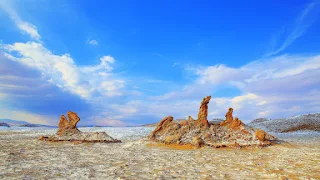Scientists have discovered microbial life found 4 meters (13 feet) below the surface of the Atacama Desert in northern Chile, the most “hostile” desert on Earth.
The Atacama Desert is known as the driest scorching desert in the world, where the sun beats violently and life seems impossible.
Scientists have found a resilient community of bacteria thriving in the extremely dry Yungai Valley. This microbial community is completely isolated from the surface world.
“To our knowledge, this represents the deepest survey and discovery of microbial life in Atacama soils to date,” the study authors stated.
Despite the harsh environment, microbial life thrives in the saline, sulfate-rich desert soil. These conditions provide a unique environment for some types of microorganisms to live.
The presence of microbial life has previously been documented at a depth of 80 cm (2.6 ft) in the Atacama Desert, where "the first 80 cm of soil is thought to be a potential refuge from harsh ultraviolet rays, a place where some water can be found." But the discovered biosphere Recently, it is "completely isolated from the surface."
To uncover this hidden biosphere, scientists, led by Dirk Wagner and his colleagues, used samples collected from soil deep beneath the surface of the Yungai Valley part of the desert, and extracted DNA recovered from the organisms.
They discovered that microbial life extends from 2 meters (6.6 feet) to at least 4 meters (13 feet) below the surface of the desert.
Types of microbes present
Firmicute phylum microbes were prevalent in the upper 80 cm of sand deposits. At less than 200 cm, a distinct microbial community was observed, dominated by Actinobacteria, a diverse group of bacteria found in other extreme environments, including the Arctic, boiling hot springs and salty seas.
While digging deeper, the team found bacteria from the phylum Firmicutes that are resilient to high concentrations of salt and do not need oxygen to survive.
During genetic analysis of microbial communities, some bacteria showed genetic similarities to two specific species: Geodermatophilus pulveris and Modestobacter caceresii. Both types of bacteria belong to the Actinobacteria family.
The scientists suggested that this community of Actinobacteria may have colonized the soil 19,000 years ago, “before it was buried by swamp sediments.” They hypothesized that this community could continue downward for an indefinite distance, representing a previously unknown deep biosphere beneath. Very dry desert soil.
Scientists hypothesize that this microbial colony could thrive at such extreme depths by obtaining water from the mineral gypsum.
The Atacama Desert is often used as an example to study the extreme conditions of Mars, where the surface is completely devoid of life, but may hide evidence of microbial life underneath.
Scientists pointed out that the new study could enhance efforts to search for life on the Red Planet, as Mars also contains gypsum deposits, which could serve as a water source for extraterrestrial life.
The study was published in the journal PNAS Nexus.
Tags:
atacama desert
driest desert
hostile desert
red planet
science
secret biosphere
topnews
yungai valley






Gud
ReplyDeleteGreat
ReplyDeleteThe discovery of microbial life 4 meters below the surface of Chile's Atacama Desert reveals the resilience of life in the most extreme environments. This finding expands our understanding of deep biospheres and has implications for astrobiology, suggesting that even on hostile planets like Mars, life might persist beneath the surface. The presence of Firmicutes and Actinobacteria at such depths challenges our assumptions about where life can exist and opens up new avenues for exploring life's adaptability in extreme conditions. This breakthrough is a remarkable step toward uncovering hidden life on Earth and beyond.
ReplyDeleteVery much
ReplyDeleteUnder review
ReplyDeleteGood
ReplyDeleteGood
ReplyDeleteGood
ReplyDeleteGood
ReplyDeleteGood
ReplyDeletefyg
ReplyDeleteGood
ReplyDeleteFine
ReplyDelete43
ReplyDeleteWow
ReplyDeleteGood
ReplyDeleteGood
ReplyDeleteGood
ReplyDeleteGood
ReplyDeleteGud
ReplyDeleteIntresting
ReplyDeleteInformative
ReplyDelete